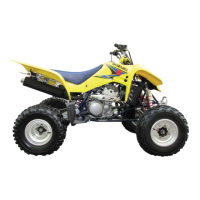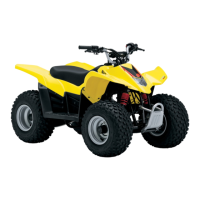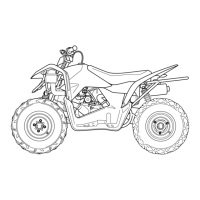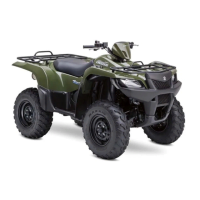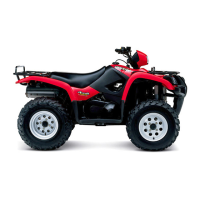ENGINE COOLANT
At
the time of manufacture, the cooling system is fitted with a
50:50 mixture of distilled water and ethylene glycol anti-freeze.
This 50:50 mixture will provide the optimum corrosion protection
and excellent heat protection, and
will protect the cooling system
fr
om
freezing at temperatures above
-3
1°C
(-2
4°F
).
If the vehicle is to be exposed to temperatures below
-3
1°C
(-24
°
F)
, this mixing ratio should be increased up to 55% or
60%
according to the figure.
I
CAUTION
I
* Use a
high
quality
ethylene
glycol
base anti-freeze,
mixed with
distilled
water. Do
not
mix an
alcohol
base anti-freeze
and
different
brands
of
anti-freeze.
• Do
not
put
in
more
than
60%
anti
-freeze
or
less
than
50
%.
(Refer
to
Right
figure
.)
..
Do
not
use
a
radiator
anti-leak
additive
.
50% Engine coolant including
re
serve tank capacity
Anti-freeze
575 ml (1.211.0
us
nmp. pi)
Waler
575 ml (1
.211.0
usnmp
. pi)
A WARNING
COOLING
AND
LUBRICATION
SYSTEM
5-3
Anti-freeze
density
50
%
55
%
60%
I'FI
I'C)
32
0
14
-10
l
-4
-20
- 22
-00
Q
c
'N
-40
-40
•
•
~
-58
-50
-
7.
-60
-94
-70
Freezing point
-31"C
(-24
'
F)
-40
'C
HO
'F)
55'C (-67"
F)
"
'\
\ /
/
· .
· .
..
·
20
40
60
80
100
Density (%)
Flg.1 Engine
coolant
density-freezing
po
int
curve.
I'F)
I'C)
302 150
(kgf/cm2)
_ 284 140
c
1
.
5.
,
'8.
266 1
30
g>
0.9
::!
•
0.5
:;
;:
248 120
S
230110
~
o
~
212 1
00
I
o
10
20
30
40
50
60
Density (%)
Fig.2 Engine
coo
lant
density
-
boiling
point
curve
.
• You can be
injured
by
scalding
fluid
or
steam
if
you
open
the
radiator
cap
when
the
engine
is
hot.
After
the
engine
cools
,
wrap
a
thick
cloth
around
cap and
carefully
remove
the
cap
by
turn
i
ng
it
a
quarter
turn
to
allow
pressure
to
escape and then turn
the
cap all the way
off
.
• The engine
must
be
cool
before
servicing
the
cooling
system.
• Coolant is
harmful
;
•
If
It
comes
in
contact
with
skin
or
eyes,
flush
with
water.
•
If
swallowed
accidentally
.
induce
vomiting
and call
physician
Immediately.
• Keep
it
away
from
children
.

